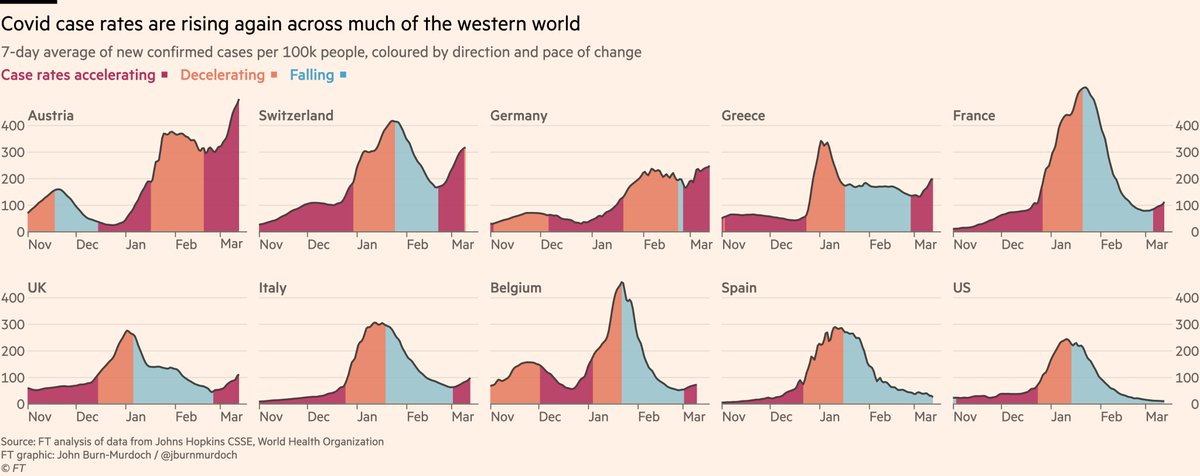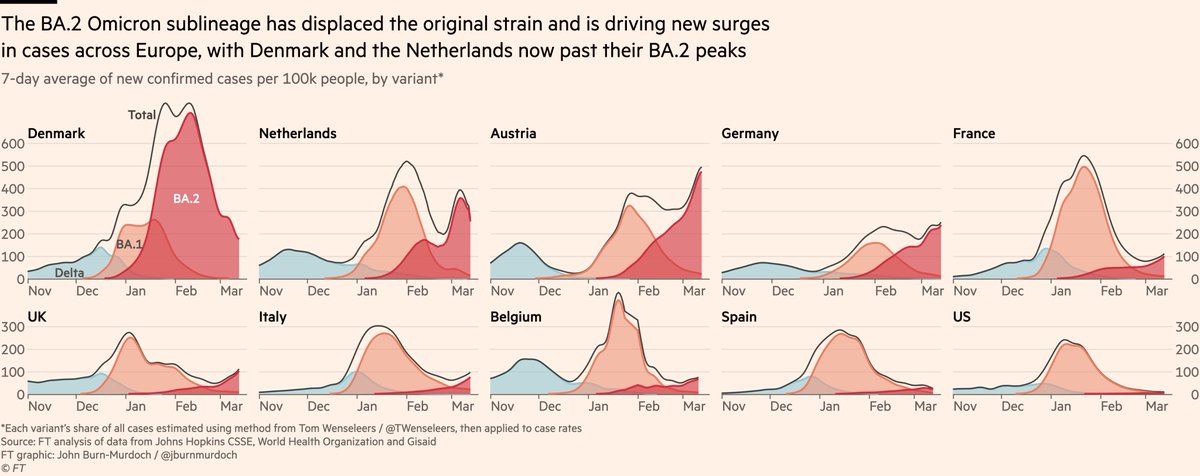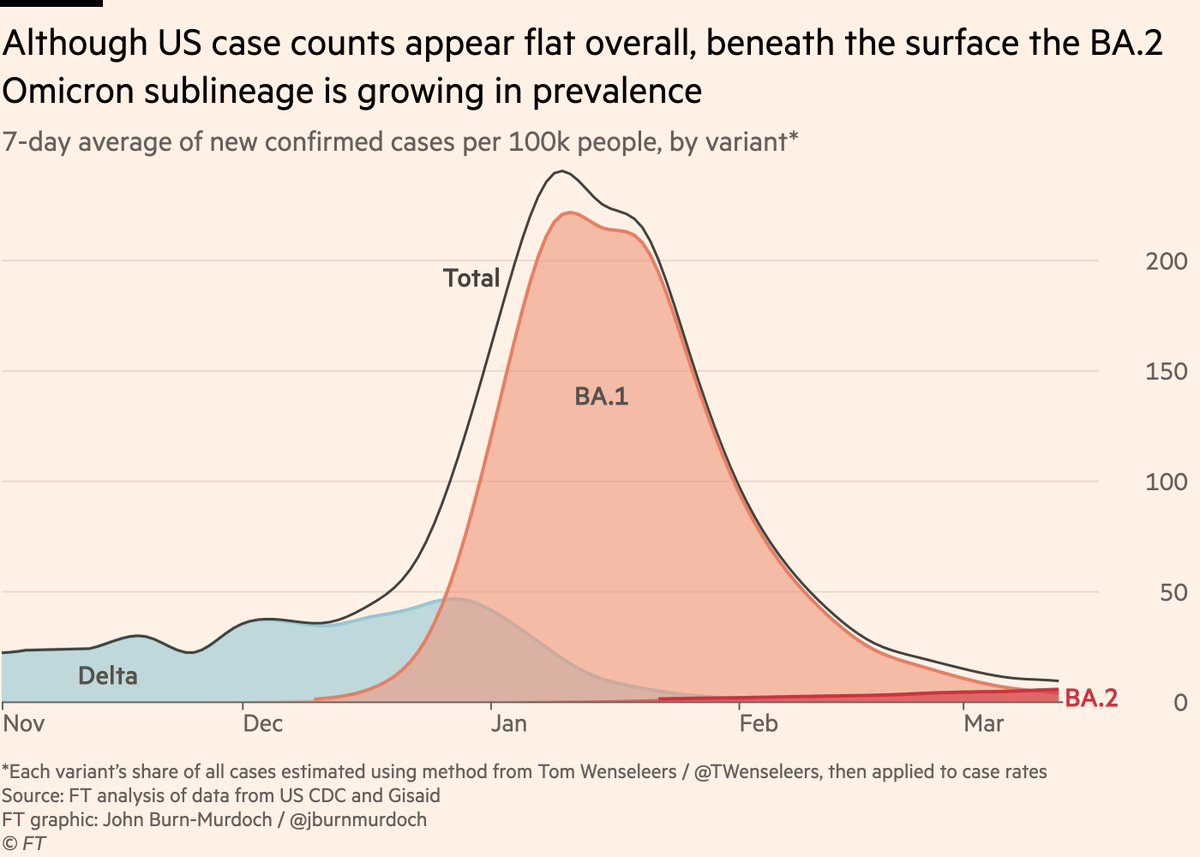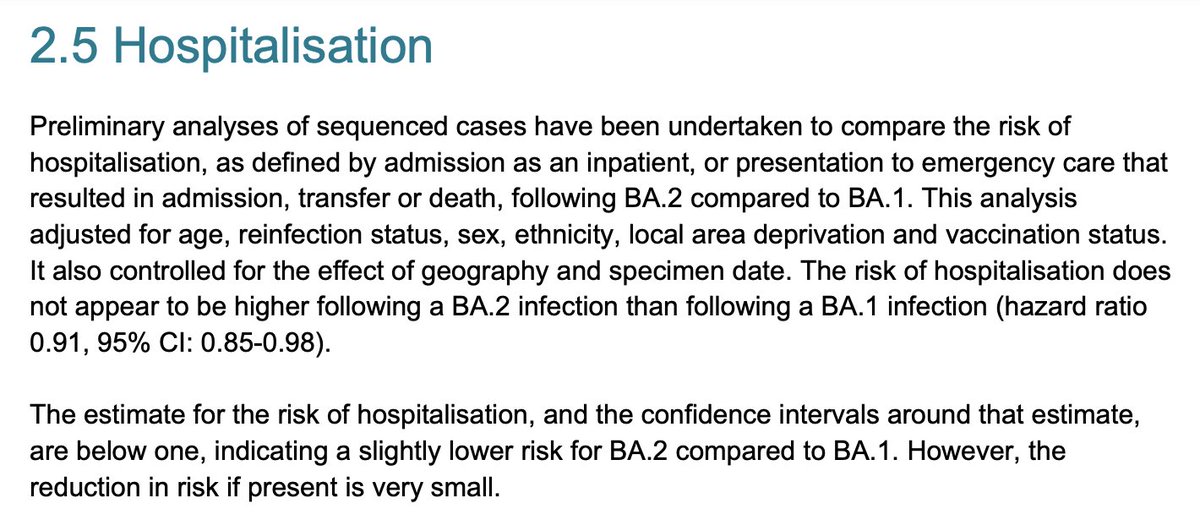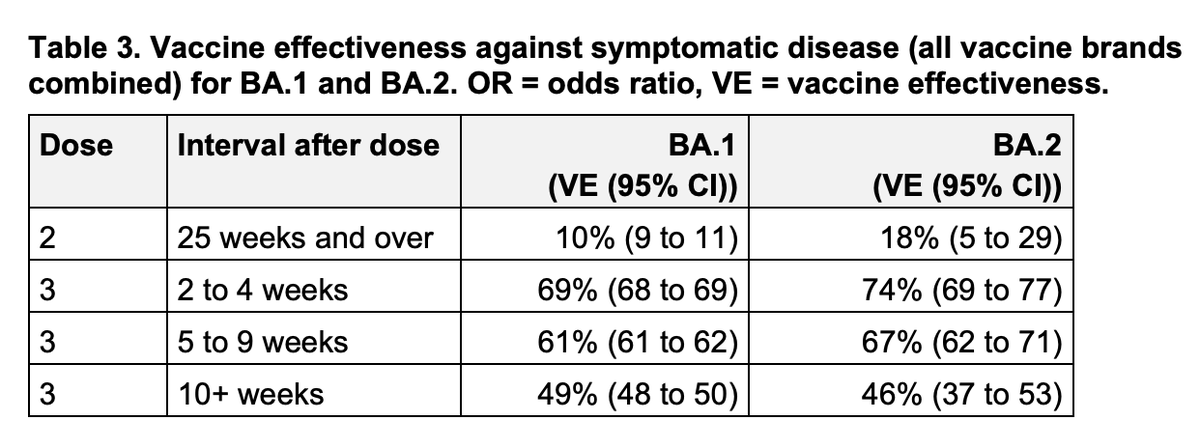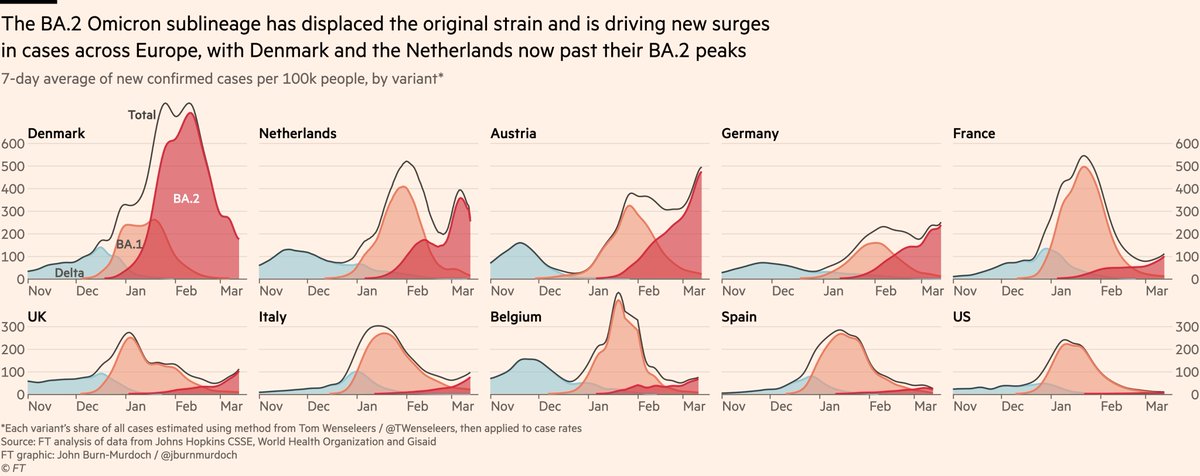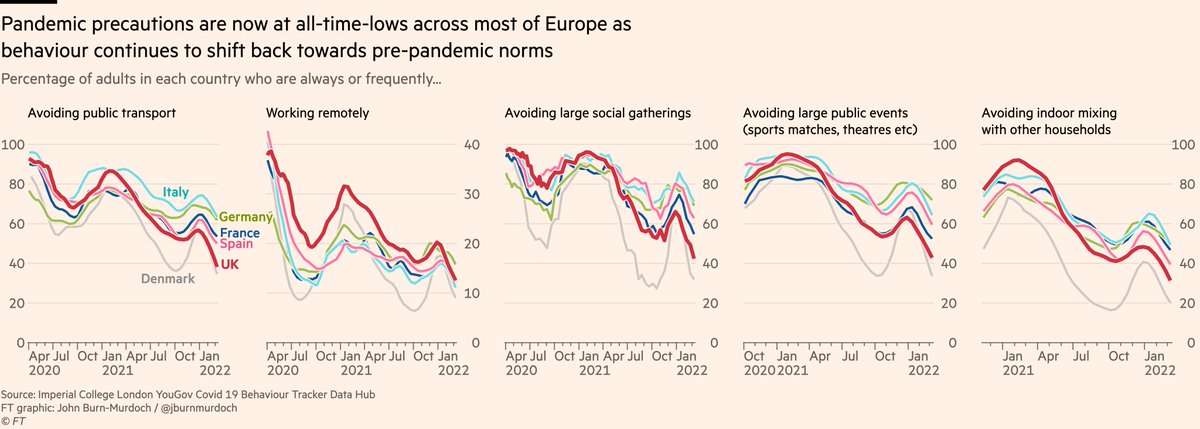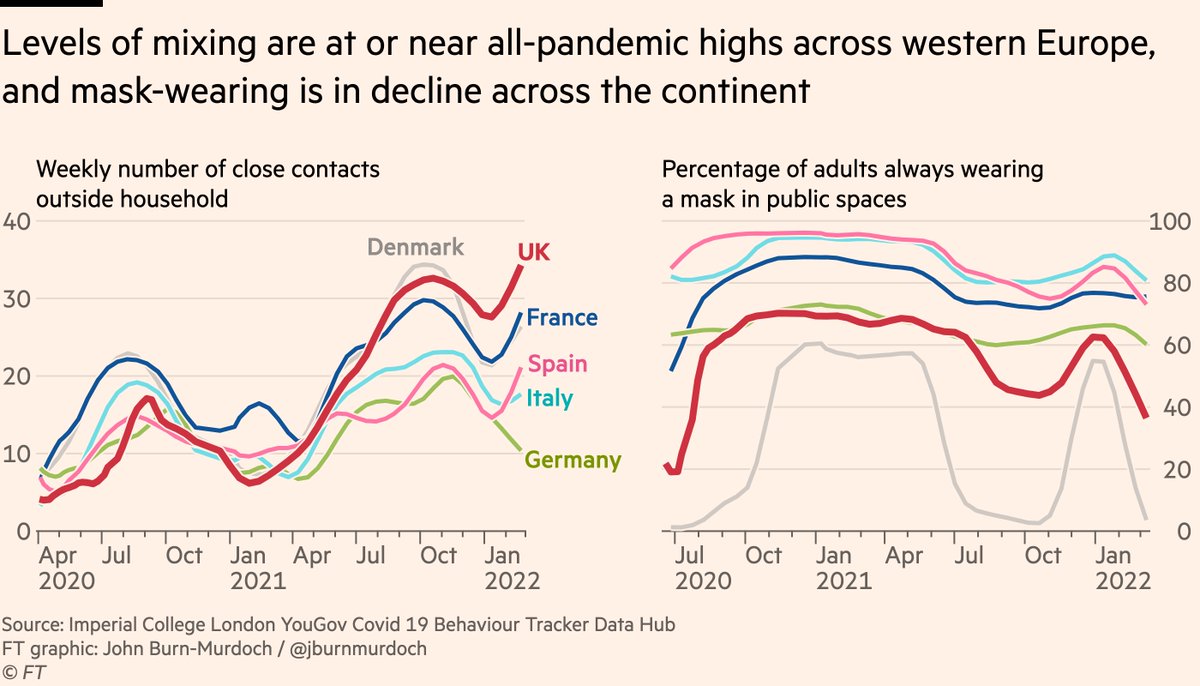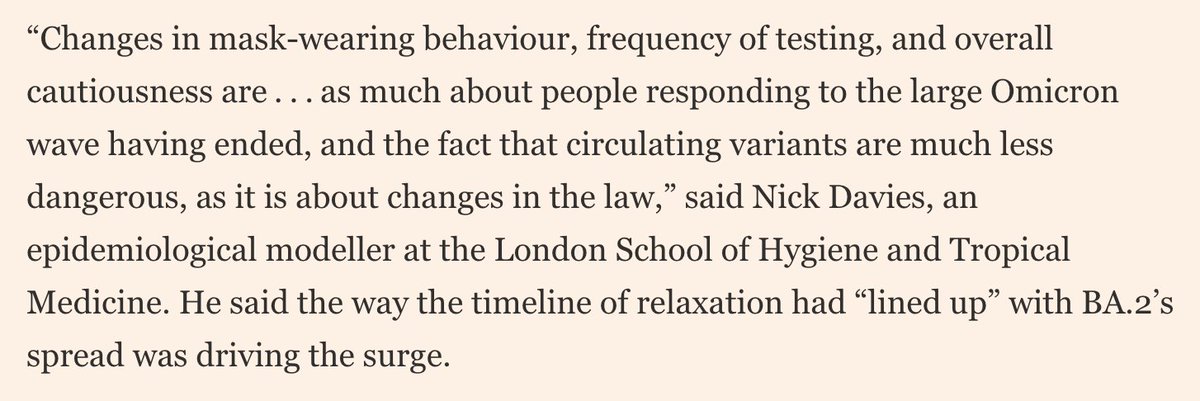NEW: time for a Covid situation update
Cases and hospitalisations are rising again across much of the western world.
What’s driving the rise, and should we be worried?
Cases and hospitalisations are rising again across much of the western world.
What’s driving the rise, and should we be worried?
What’s behind the rise?
Some blame governments dropping restrictions, but the answer is the same as always: it’s the virus. Specifically the BA.2 Omicron strain.
Here are UK hospitalisations, split by variant. That mystery resurgence? Not so mysterious with this context added.
Some blame governments dropping restrictions, but the answer is the same as always: it’s the virus. Specifically the BA.2 Omicron strain.
Here are UK hospitalisations, split by variant. That mystery resurgence? Not so mysterious with this context added.
And when the virus changes the narrative, it doesn’t just change it in one country, it changes it everywhere.
Here’s same chart, but for Europe & US.
It’s the same story. What looked like mystery double-peaks are now clearly a BA.1 peak followed by BA.2.
Here’s same chart, but for Europe & US.
It’s the same story. What looked like mystery double-peaks are now clearly a BA.1 peak followed by BA.2.
And for those of you in the US looking at that last chart and saying "what resurgence? everything seems fine here", here’s a closer look at what’s happening beneath the surface of that apparently flat trend.
We’ve been here before, and I think we know what happens next by now...
We’ve been here before, and I think we know what happens next by now...
So, BA.2’s transmissibility advantage over BA.1 is driving the resurgence.
Next question: should we be worried?
The good news here is that analysis by @UKHSA has found that:
1) Infection with BA.2 is no more likely to result in hospitalisation than BA.1 https://assets.publishing.service.gov.uk/government/uploads/system/uploads/attachment_data/file/1060337/Technical-Briefing-38-11March2022.pdf">https://assets.publishing.service.gov.uk/governmen...
Next question: should we be worried?
The good news here is that analysis by @UKHSA has found that:
1) Infection with BA.2 is no more likely to result in hospitalisation than BA.1 https://assets.publishing.service.gov.uk/government/uploads/system/uploads/attachment_data/file/1060337/Technical-Briefing-38-11March2022.pdf">https://assets.publishing.service.gov.uk/governmen...
And 2) vaccines (specifically boosters) are just as effective against BA.2 as against the original BA.1 strain https://assets.publishing.service.gov.uk/government/uploads/system/uploads/attachment_data/file/1061532/Vaccine_surveillance_report_-_week_11.pdf">https://assets.publishing.service.gov.uk/governmen...
So while a resurgence is never good news, BA.2 is Omicron just as BA.1 was, so we have a decent idea of what that looks like in terms of severe disease & death
The BA.2 wave will still cause deaths, but with high levels of immunity, the tolls will be dwarfed by pre-vaccine waves
The BA.2 wave will still cause deaths, but with high levels of immunity, the tolls will be dwarfed by pre-vaccine waves
We can also revisit those earlier charts:
Denmark & Netherlands are already descending from BA.2 peaks, so we know that what goes up, comes down.
The height of BA.2 peaks varies. Denmark’s piggy-backed on BA.1 and rose higher. Netherlands came after and reached a similar height
Denmark & Netherlands are already descending from BA.2 peaks, so we know that what goes up, comes down.
The height of BA.2 peaks varies. Denmark’s piggy-backed on BA.1 and rose higher. Netherlands came after and reached a similar height
Lots of factors will affect the specifics in any given country, including levels of immunity and mixing behaviour.
On that latter point, most of us have been taking things a little easier in recent weeks, with behaviour shifting back towards pre-pandemic norms.
The number of people working remotely, avoiding large indoor gatherings etc, is at or near an all-pandemic low across western Europe
The number of people working remotely, avoiding large indoor gatherings etc, is at or near an all-pandemic low across western Europe
And it’s a similar story in most countries in terms of masks and total numbers of close-contacts, both of which are about as close to 2019 levels as they have been, or heading that way fast.
Here’s our story on behaviour trending back to the old normal: https://www.ft.com/content/abb2f882-0eff-42df-969a-a02f22f3a4a1">https://www.ft.com/content/a...
Here’s our story on behaviour trending back to the old normal: https://www.ft.com/content/abb2f882-0eff-42df-969a-a02f22f3a4a1">https://www.ft.com/content/a...
So while the coming BA.2 wave shouldn’t be a crisis for any country with high immunity levels, it does perhaps serve as a useful illustration of where we (well-vaccinated countries) are with Covid now, two-and-a-bit years into the pandemic:
Vaccine rollouts have been enormous successes, immunity levels are high. As a result, any given Omicron infection has a similar fatality risk as seasonal flu, and we’re mixing indoors again. In that sense we’re as close to 2019 as we have ever been https://twitter.com/jburnmurdoch/status/1501886435145699328
But...">https://twitter.com/jburnmurd...
But...">https://twitter.com/jburnmurd...
What BA.2 is demonstrating is that we’re still in a very different infectious disease environment to where we were before Covid.
To be clear, I don’t say this to worry anyone: I say it in the hope that that people are *less* surprised/worried when this and future waves unfold.
To be clear, I don’t say this to worry anyone: I say it in the hope that that people are *less* surprised/worried when this and future waves unfold.
As @ewanbirney put it to us, before Covid we had 4 coronaviruses circulating in the population. Now we have 5, and the 5th is especially transmissible.
As @zorinaq shows below, that means we get more waves of Covid in any given year than we got flu waves https://twitter.com/zorinaq/status/1503782053531193346">https://twitter.com/zorinaq/s...
As @zorinaq shows below, that means we get more waves of Covid in any given year than we got flu waves https://twitter.com/zorinaq/status/1503782053531193346">https://twitter.com/zorinaq/s...
So, as we showed in our story last week, despite Covid being less lethal than it has ever been, the overall risk of infection, post-viral syndrome (long-Covid), severe disease and death remains markedly higher than it was in 2019 https://twitter.com/jburnmurdoch/status/1501886468322701315">https://twitter.com/jburnmurd...
Our behaviour continues to trend towards 2019 levels. For many people, life feels quite normal, and I’m the last person who would say "you can never go back to normal! precautions forever!"
But in terms of infectious disease environment, this *is* a new normal, not the old one.
But in terms of infectious disease environment, this *is* a new normal, not the old one.
Ultimately, the questions — not only with BA.2, but with Covid more broadly in the months & years ahead — are what Covid’s typical annual toll on public health will be, whether we fully appreciate this, and whether we (and our healthcare systems) are resourced for the new normal.
As @AdamJKucharski put it to us, acute spikes are unlikely, but chronic plateaus could be very uncomfortable too https://www.ft.com/content/abb2f882-0eff-42df-969a-a02f22f3a4a1">https://www.ft.com/content/a...
Finally, I just want to touch on another issue that I think BA.2 highlights:
Throughout the pandemic there has been a tendency to try to explain the virus’ dynamics by pointing to nice neat explanations around government policy. Mask mandates, dropping isolation etc.
Throughout the pandemic there has been a tendency to try to explain the virus’ dynamics by pointing to nice neat explanations around government policy. Mask mandates, dropping isolation etc.
While those things certainly have impacts, there are two things to note:
• First, they pale into significance compared to the impact of new variants, whose emergence we have relatively little control over. Not everything can be blamed on a person/policy
• First, they pale into significance compared to the impact of new variants, whose emergence we have relatively little control over. Not everything can be blamed on a person/policy
• And second, despite two years of evidence to the contrary, we continue to attribute to policy what is better understood as people making independent decisions in response to the status of the pandemic, with policy being just one influence.
As @_nickdavies put it to us:
As @_nickdavies put it to us:

 Read on Twitter
Read on Twitter